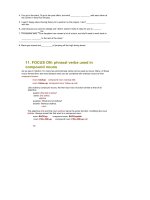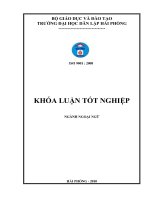- Trang chủ >>
- Mầm non >>
- Mẫu giáo lớn
compound adjectives and compound nouns
Bạn đang xem bản rút gọn của tài liệu. Xem và tải ngay bản đầy đủ của tài liệu tại đây (141.9 KB, 4 trang )
<span class='text_page_counter'>(1)</span><div class='page_container' data-page=1>
COMPOUND ADJECTIVES (Tính từ kép)
<b>16. COMPOUND ADJECTIVES</b>
<b>(Tính từ kép)</b>
<b>16.1 Cách viết:</b>
Tính từ kép thường gồm hai (hoặc nhiều) từ kết hợp với nhau và được dùng như một từ duy nhất. Tính
từ kép có thể được viết:
thành một từ duy nhất:
life + long = lifelong (cả đời)
home + sick = homesick (nhớ nhà)
thành hai từ có dấu gạch nối ở giữa:
heart + broken = heart-broken (đau khổ)
fast + growing = fast-growing (phát triển nhanh)
<b>16.2 Cấu tạo:</b>
Tính từ kép có thể được tạo thành bởi:
Danh từ + tính từ:
nation-wide (khắp nước)
noteworthy (đáng chú ý)
duty-free (miễn thuế)
blood-thirsty (khát máu)
Danh từ + phân từ:
time-consuming (tốn thời gian)
handmade (làm bằng tay)
breath-taking (đáng kinh ngạc)
heart-broken (đau khổ)
Phó từ + phân từ:
outspoken (thẳng thắn)
ill-equipped (trang bị tồi)
high-sounding (huênh hoang)
well-behaved (lễ phép)
Tính từ + phân từ:
beautiful-sounding (nghe hay)
good-looking (xinh xắn)
easy-going (thoải mái)
middle-ranking (cỡ trung bình)
</div>
<span class='text_page_counter'>(2)</span><div class='page_container' data-page=2>
old-fashioned (lỗi thời)
fair-skinned (da trắng)
absent-minded (đãng trí)
artistic-minded (có óc thẩm mỹ)
<b>NHỮNG LỖI THƯỜNG PHẠM</b>
<b>Dùng sai cấu tạo từ:</b>
*a nicely-looking jacket
[phải dùng <i>a nice-looking jacket</i> (tính từ + phân từ)]
*a new-married couple
[phải dùng <i>a newly-married couple</i> (phó từ + phân từ)]
<b>Viết sai hình thức so sánh bậc hơn và bậc nhất (comparative & superlative forms):</b>
*older-fashioned, *oldest-fashioned
[phải viết <i>more old-fashioned, most old-fashioned</i>]
*better-to-do, *best-to-do
[phải viết <i>more well-to-do, most well-to-do</i>]
<b>Compound Nouns - Danh từ ghép</b>
A compound noun is a noun that is made with two or more words. A compound noun is usually
<b>[noun + noun] or [adjective + noun], but there are other combinations (see below). It is important </b>
to understand and recognize compound nouns. Each compound noun acts as a single unit and can
be modified by adjectives and other nouns.
Danh từ ghép là danh từ nó được thành lập từ hai hay nhiều từ trở lên. Danh từ ghép thường được
cấu thành như [danh từ + danh từ] hoặc [tính từ + danh từ], nhưng ngồi ra cũng cịn có những
cách ghép khác(hãy xem bảng dưới). Để hiểu và nhận ra danh từ ghép rất quan trọng. Mỗi danh từ
ghép là một đơn vị riêng lẻ và có thể được bổ nghĩa bởi một tính từ hay những danh từ khác.
There are three forms for compound nouns:
Có 3 cách thể hiện danh từ ghép như sau:
open or spaced - space between words (tennis shoe) có khoản cách giữa hai từ như tennis shoe -
<b>giày quần vợt</b>
hyphenated - hyphen between words (six-pack) dùng dấu gạch giữa ở giữa "-" hai từ như six-pack
closed or solid - no space or hyphen between words (bedroom) không chừa khoản trống hay dấu
gạch giữ ở giữa hai từ chúng viết liền nhau như bedroom.
Here are some examples of compound nouns:
Dưới đây là một vài ví dụ về danh từ ghép:
noun + noun bus stop Is this the <b>bus stop</b> for the number 12
bus?
fire-fly In the tropics you can see <b>fire-flies</b> at
night.
football Shall we play <b>football</b> today?
adjective + noun full moon I always feel crazy at <b>full moon</b>.
blackboard Clean the <b>blackboard</b> please.
software I can't install this <b>software</b> on my PC.
verb(-ing) + noun breakfast We always eat <b>breakfast</b> at 8am.
washing
machine Put the clothes in the red <b>machine</b>. <b>washing </b>
swimming
</div>
<span class='text_page_counter'>(3)</span><div class='page_container' data-page=3>
noun + verb(-ing) sunrise I like to get up at <b>sunrise</b>.
haircut You need a <b>haircut</b>.
train-spotting His hobby is <b>train-spotting</b>.
verb + preposition check-out Please remember that <b>check-out</b> is at 12
noon.
noun + prepositional
phrase mother-in-law My <b>mother-in-law</b> lives with us.
preposition + noun underworld Do you think the police accept money from
the<b>underworld</b>?
noun + adjective truckful We need 10 truckfuls of bricks.
<b>Pronunciation - Cách đọc</b>
Compound nouns tend to have more stress on the first word. In the phrase "pink ball", both words
are equally stressed (as you know, adjectives and nouns are always stressed). In the compound
noun "golf ball", the first word is stressed more (even though both words are nouns, and nouns are
always stressed). Since "golf ball" is a compound noun we consider it as a single noun and so it has
a single main stress - on the first word. Stress is important in compound nouns. For example, it
helps us know if somebody said "a GREEN HOUSE" (a house which is painted green) or "a
GREEN house" (a building made of glass for growing plants inside).
Danh từ ghép thường được đọc nhấn mạnh ở từ đầu tiên. Trong cụm từ "pink ball", cả hai từ đều có
cùng âm nhấn(tính từ và danh từ ln ln cùng được nhấn). Ở từ ghép "golf ball" thì từ đầu tiên
được nhấn mạnh hơn(mặc dù cả 2 đều là danh từ và hai từ này cũng được nhấn). Vì "golf ball"
được xem như là một danh từ riêng lẽ và nó có một điểm nhấn chính ở từ đầu tiên). Việc nhấn ở
đâu rất quan trọng trong danh từ ghép. Ví dụ danh từ "a GREEN HOUSE" (đây là căn nhà được
sơn màu xanh dương) cịn "a GREEN house" (một ngơi nhà làm bằng thủy tinh để trồng cây xanh)
<b>British/American differences - Sự khác nhau giữa tiếng Anh của người Anh và người Mỹ</b>
Different varieties of English, and even different writers, may use the open, hyphenated or closed
form for the same compound noun. It is partly a matter of style. There are no definite rules. For
example we can find:
Giữa tiếng Anh của người Anh và người Mỹ rất khác nhau có người thì chừa khoảng cách giữa 2
từ, có người thì dùng dấu "-" giữa 2 từ, có người thì viết hai từ liền nhau, như ví dụ sau:
container ship
container-ship
containership
If you are not sure which form to use, please check in a good dictionary.
Nếu bạn khơng chắc chắn cách nào đúng thì nên tra trong những từ điển chuẩn để rỏ hơn.
<b>Plural forms of compound nouns - Số nhiều của danh từ ghép</b>
In general we make the plural of a compound noun by adding -s to the "base word" (the most
"significant" word). Look at these examples:
Nói chung chúng ta thành lập số nhiều của danh từ ghép bằng cách thêm s vào từ chính của từ ghép
đó. Ví dụ
<b>singular</b> <b>plural</b>
a school teacher three <b>school teachers</b>
one assistant headmaster five <b>assistant headmasters</b>
the sergeant major some <b>sergeants major</b>
a mother-in-law two <b>mothers-in-law</b>
an assistant secretary of state three <b>assistant secretaries of state</b>
my toothbrush our <b>toothbrushes</b>
a woman-doctor four <b>women-doctors</b>
a doctor of philosophy two <b>doctors of philosophy</b>
a passerby, a passer-by two <b>passersby</b>, two <b>passers-by</b>
</div>
<span class='text_page_counter'>(4)</span><div class='page_container' data-page=4>
old style (spoonsful) and the new style (spoonfuls) are normally acceptable, but you should be
consistent in your choice. Here are some examples:
Hãy chú ý với những từ như spoonful hay truckful. Theo cách dùng cũ thì người ta dùng spoonsful
hay trucksful cho số nhiều. Còn ngày nay thì người ta thường dùng spoonfuls hay truckfuls cho số
nhiều. Cả hai cách đều được chấp nhận, nhưng phải nhất quán trong cách dùng. Ví dụ:
<b>old style plural</b>
<b>(very formal)</b> <b>new style plural</b>
teaspoonful 3 <b>teaspoonsful</b> of sugar 3 <b>teasponfuls</b> of sugar
truckful 5 <b>trucksful</b> of sand 5 <b>truckfuls</b> of sand
bucketful 2 <b>bucketsful</b> of water 2 <b>bucketfuls</b> of water
cupful 4 <b>cupsful</b> of rice 4 <b>cupfuls</b> of rice
Some compound nouns have no obvious base word and you may need to consult a dictionary to
find the plural:
Có một số từ khơng có nguồn gốc rõ ràng, bạn nên dùng từ điển để xem. Ví du:
<b>higher-ups</b>
<b>also-rans</b>
<b>go-betweens</b>
<b>has-beens</b>
<b>good-for-nothings</b>
<b>grown-ups</b>
Note that with compound nouns made of [noun + noun] the first noun is like an adjective and
therefore does not usually take an -s. A tree that has apples has many apples, but we say an apple
<b>tree, not apples tree; matchbox not matchesbox; toothbrush not teethbrush.</b>
Chú ý đối với những từ ghép được thành lập bởi 2 danh từ [danh từ + danh từ] danh từ đầu xem
như tính từ bởi vậy thường khơng the s vào.
With compound nouns made of [noun + noun] the second noun takes an -s for plural. The first noun
acts like an adjective and as you know, adjectives in English are invariable. Look at these
examples:
Với những từ ghép được thành lập bởi hai danh từ [danh từ + danh từ] mà danh từ thứ 2 thêm s để
thành lập số nhiều, thì danh từ đầu giữ vị trí như một tính từ
<b>long plural form becomes › plural compound noun</b>
<b>[noun + noun]</b>
100 trees with apples 100 <b>apple trees</b>
1,000 cables for telephones 1,000 <b>telephone cables</b>
20 boxes for tools 20 <b>tool boxes</b>
</div>
<span class='text_page_counter'>(5)</span><div class='page_container' data-page=5></div>
<!--links-->









